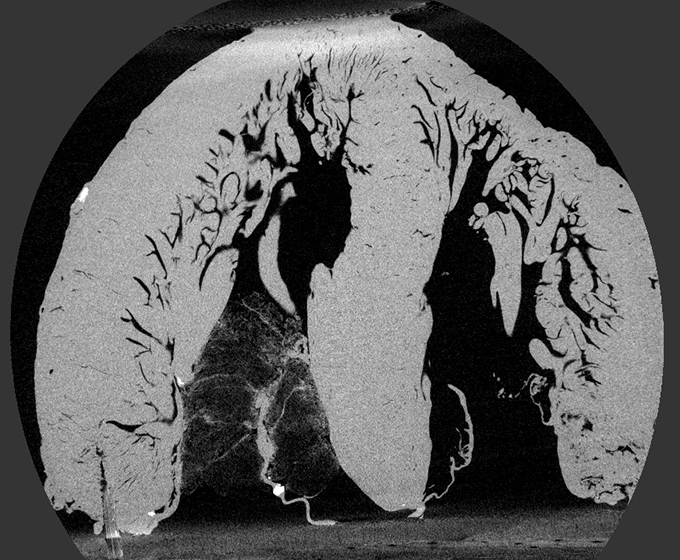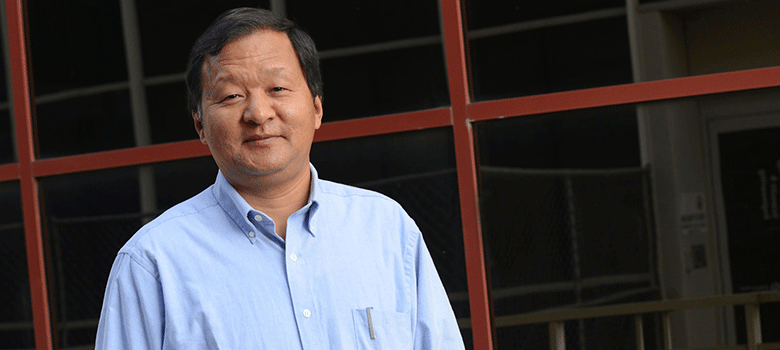
UTSA and SwRI are collaborating to create a computer model of the tubular structures in the human heart as part of a larger effort to develop a new, potentially life-saving heart surgery. These structures, called the trabeculae carneae, are poorly understood and most models of the heart ignore them.
AUGUST 10, 2021 — The University of Texas at San Antonio and Southwest Research Institute (SwRI) are collaborating to create a computer model of the intricate structures of the human heart as part of a larger effort to develop a new, potentially life-saving heart surgery.
The work, led by Keith Bartels of SwRI’s Mechanical Engineering Division and Hai-Chao Han of UTSA’s College of Engineering and Integrated Design, is supported by a $125,000 grant from the Connecting through Research Partnerships (Connect) Program.
Within the human heart are numerous small muscle bundles called the trabeculae carneae. Despite their significance to the heart’s anatomy, their function is not well understood and most models of the heart ignore them.
As people grow older, heart muscles can grow stiff, reducing efficiency and sometimes resulting in untreatable diastolic heart failure. SwRI and UTSA are scanning cadaver hearts using a powerful computer tomography (CT) scanner at SwRI to inform a potential new surgical intervention.

UTSA professor and Zachry Mechanical Engineering Department Endowed Chair Hai-Chao Han is collaborating with SwRI's Keith Bartels to create a computer model of the intricate structures of the human heart.
“Capturing the intricate structures of the trabeculae carneae requires something more powerful than an MRI or standard CT scanners,” Bartels said. “We’ll utilize a micro-focus X-ray CT scanner here at SwRI to create images of explanted human hearts.”
The images of the heart’s intricate inner structures will help Han to create a realistic anatomical model of the trabeculae carneae, building on a previous model he developed for the left ventricle.
“This collaboration with SwRI is a first step toward creating a new surgical method,” Han explained. “The computer model will help to provide a much deeper understanding of the trabeculae carneae.”
The images of the heart’s intricate inner structures will help Han to create a realistic anatomical model of the trabeculae carneae. Han has also been working with cardiologist Marc Feldman at UT Health San Antonio to develop a surgical treatment for subgroups of heart failure patients. This project is a critical step for the efforts.
“I hope that this work can ultimately improve the quality of people’s lives and even save lives in the long run,” Bartels said. “Heart failure is a major problem that affects millions of people.”
SwRI’s Executive Office and UTSA’s Office of the Vice President for Research, Economic Development, and Knowledge Enterprise sponsor the Connect program, which offers grant opportunities to enhance greater scientific collaboration between the two institutions.
UTSA Today is produced by University Communications and Marketing, the official news source of The University of Texas at San Antonio. Send your feedback to news@utsa.edu. Keep up-to-date on UTSA news by visiting UTSA Today. Connect with UTSA online at Facebook, Twitter, Youtube and Instagram.
Move In To COLFA is strongly recommended for new students in COLFA. It gives you the chance to learn about the Student Success Center, campus resources and meet new friends!
Academic Classroom: Lecture Hall (MH 2.01.10,) McKinney Humanities BldgWe invite you to join us for Birds Up! Downtown, an exciting welcome back event designed to connect students with the different departments at the Downtown Campus. Students will have the opportunity to learn about some of the departments on campus, gain access to different resources, and collect some giveaways!
Bill Miller PlazaJoin us for an intimate evening of cocktails, conversation, and culinary inspiration with Pati Jinich, Emmy-nominated chef and James Beard Award-winning author. Enjoy light bites and signature drinks in the warm, modern setting of Mezquite as Pati connects with guests over her passion for Mexican cuisine and storytelling.
Mezquite Restaurant in Pullman Market, 221 Newell Ave., San Antonio 78215From inspired courses to thoughtful pairings and a rich sense of community, the Ven a Comer Signature Dinner is a night of shared meals, shared stories, and unforgettable flavor.
Stable Hall (Pear Brewery), 307 Pearl Pkwy, San Antonio 78215Come and celebrate this year's homecoming at the Downtown Campus with food, games, giveaways, music, and more. We look forward to seeing your Roadrunner Spirit!
Bill Miller PlazaThe University of Texas at San Antonio is dedicated to the advancement of knowledge through research and discovery, teaching and learning, community engagement and public service. As an institution of access and excellence, UTSA embraces multicultural traditions and serves as a center for intellectual and creative resources as well as a catalyst for socioeconomic development and the commercialization of intellectual property - for Texas, the nation and the world.
To be a premier public research university, providing access to educational excellence and preparing citizen leaders for the global environment.
We encourage an environment of dialogue and discovery, where integrity, excellence, respect, collaboration and innovation are fostered.